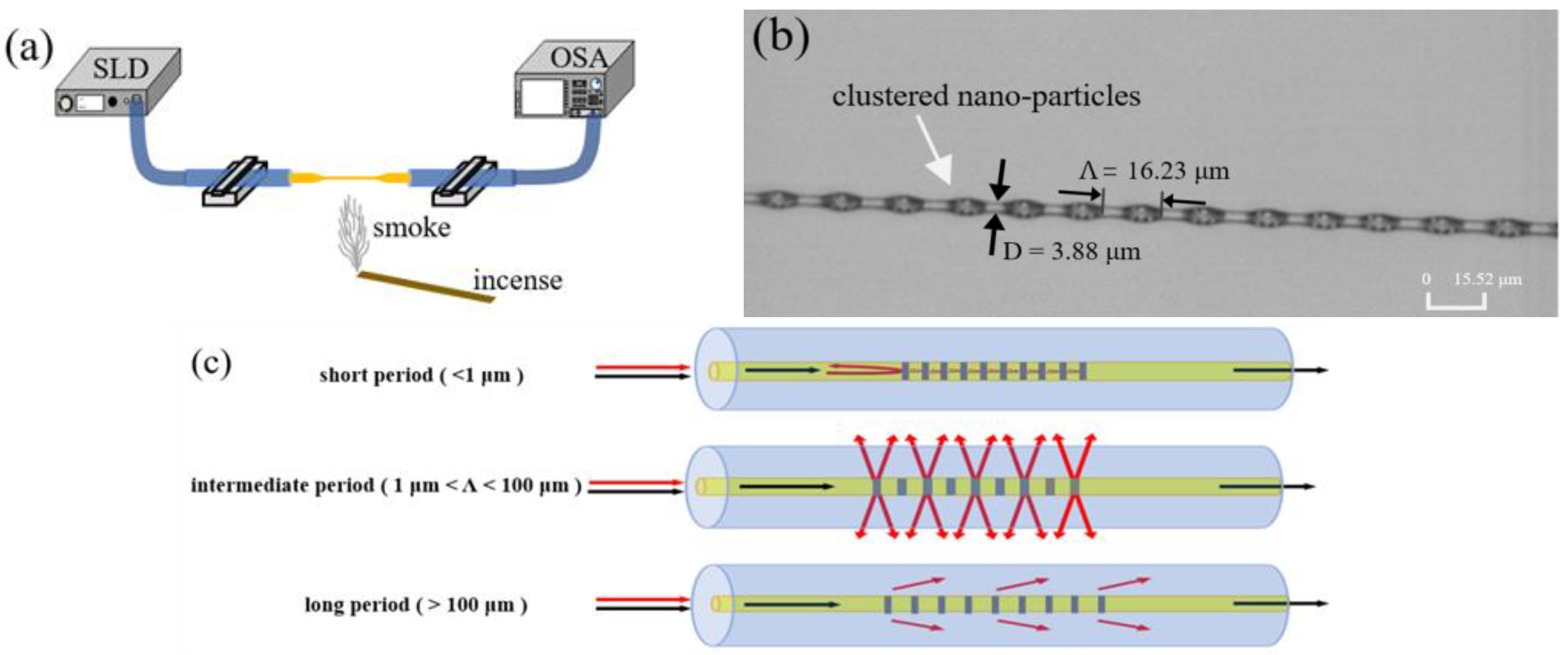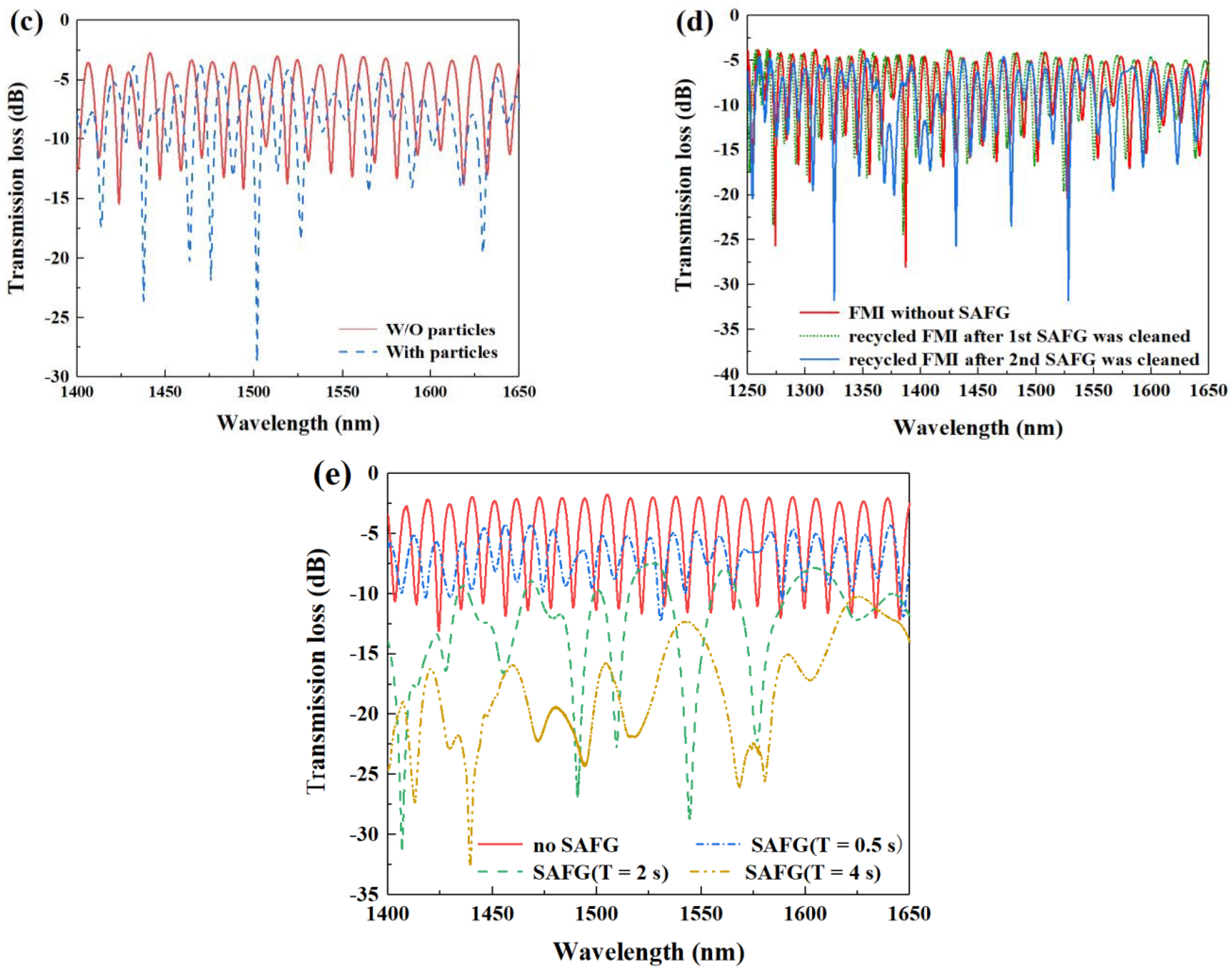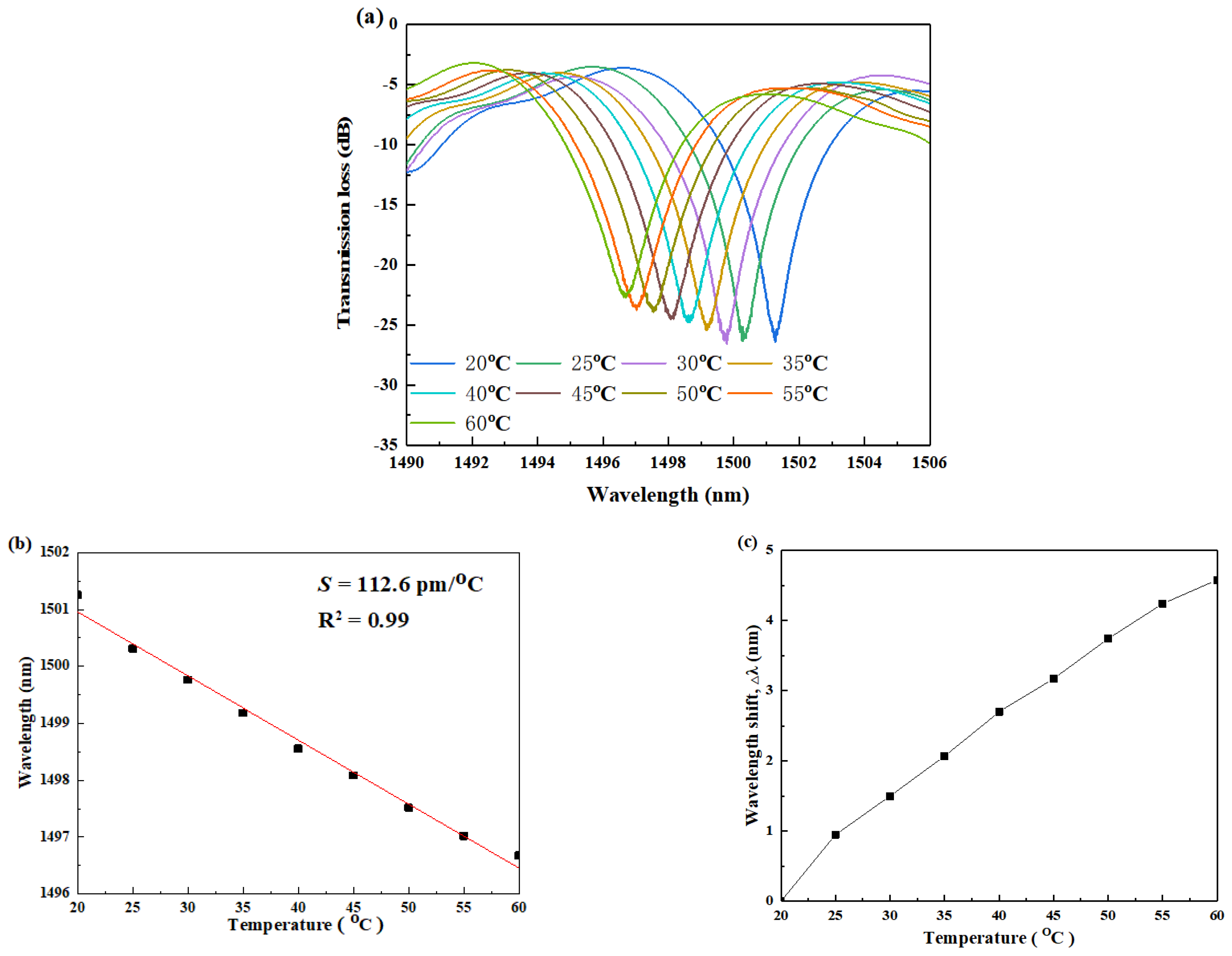Micro-Tapered Fiber Few-Mode Interferometers Incorporated by Molecule Self-Assembly Fiber Grating for Temperature Sensing Applications
Abstract
:1. Introduction
2. Experimental Set-Up and Working Principle
3. Measurements and Discussion
4. Conclusions
Author Contributions
Funding
Institutional Review Board Statement
Informed Consent Statement
Data Availability Statement
Acknowledgments
Conflicts of Interest
References
- Dong, S.D.; Dong, B.; Yu, C.Y.; Guo, Y.X. High sensitivity optical fiber curvature sensor based on cascaded fiber interferometer. J. Lightwave Technol. 2018, 36, 1125–1130. [Google Scholar] [CrossRef]
- Avila-Garcia, M.S.; Bianchetti, M.; Corre, R.L.; Guevel, A.; Mata-Chavez, R.L.; Sierra-Hernandez, J.M.; Jauregui-Vazquez, D.; Reyes-Ayona, J.R.; Wstudillo-Ayala, J.M.; Rojas-Laguna, R. High sensitivity strain sensors based on single-mode-fiber core-offset Mach-Zehnder interferometers. Opt. Lasers Eng. 2018, 107, 202–206. [Google Scholar] [CrossRef]
- Chen, E.Q.; Dong, B.; Li, Y.; Wang, X.L.; Zhao, Y.D.; Xu, W.; Zhao, W.; Wang, Y.S. Cascaded few-mode fiber down-taper modal interferometers and their application in curvature sensing. Opt. Commun. 2020, 475, 126274. [Google Scholar] [CrossRef]
- Erdogan, T.; Mizrahi, V. Characterization of UV-induced birefringence in photosensitive Ge-doped silica optical fibers. J. Opt. Soc. Am. B 1994, 11, 2100–2105. [Google Scholar] [CrossRef]
- Hill, K.O.; Meltz, G. Fiber Bragg grating technology fundamentals and overview. J. Lightwave Technol. 1997, 15, 1263–1276. Available online: https://ieeexplore.ieee.org/document/618320 (accessed on 11 January 2022). [CrossRef] [Green Version]
- Feng, J.B.; Zhou, Z.P. Polarization beam splitter using a binary blazed grating coupler. Opt. Lett. 2007, 32, 1662–1664. [Google Scholar] [CrossRef] [PubMed] [Green Version]
- Cameron, R.P.; Yao, A.M.; Barnet, S.M. Diffraction gratings for chiral molecules and their applications. J. Phys. Chem. A 2014, 118, 3472–3478. [Google Scholar] [CrossRef] [PubMed]
- Sun, C.T.; Wang, R.; Jin, X.R.; Wang, Z.M.; Liu, W.L.; Zhang, S.; Zhang, Y.W.; Lin, J.Y.; Li, Y.; Geng, T.; et al. A new phase-shifted long-period fiber grating for simultaneous measurement of torsion and temperature. Chin. Opt. Lett. 2020, 2, 39–43. [Google Scholar] [CrossRef]
- Liu, K.; Neo, D.W.K.; Bi, G.J.; Liu, S.B.; Xu, P.; Wang, H.; Nichlas, T.Y.J.; Low, D.W.W.; Zhou, G.Y. Diamond shaping of blazed gratings on freeform surfaces. Precis. Eng. 2021, 72, 899–911. [Google Scholar] [CrossRef]
- Xu, F.; Kou, J.L.; Luo, W.; Lu, Y.Q. Surface-Corrugated Microfiber Bragg Grating. In Proceedings of the 2012 Society of Photo-Optical Instrumentation Engineers (SPIE): (SPIE, 2012), Optoelectronic Devices and Integration IV, Beijing, China, 27 November 2012; Volume 8555, p. 23. Available online: https://www.spie.org/Publications/Proceedings/Paper/10.1117/12.999530 (accessed on 6 December 2021).
- Erdogan, T. Fiber grating spectra. J. Lightwave Technol. 1997, 15, 1277–1294. Available online: https://ieeexplore.ieee.org/document/618322 (accessed on 13 January 2022). [CrossRef] [Green Version]
- Yamashita, S.; Baba, T.; Kashiwagi, K. Frequency-Shifted Multiwavelength FBG Laser Sensor. In Proceedings of the 2002 15th Optical Fiber Sensors Conference Technical Digest (OFS), Portland, OR, USA, 7 August 2002; pp. 285–288. Available online: https://ieeexplore.ieee.org/document/1000558 (accessed on 6 January 2022).
- Cuadrado-Laborde, C.; Díez, A.; Cruz, J.L.; Andrés, M.V. Doubly active Q switching and mode locking of an all-fiber lase. Opt. Lett. 2009, 34, 2709–2711. [Google Scholar] [CrossRef]
- Li, X.; Bohn, P.W. Metal-assisted chemical etching in HF/ H2O2 produces porous silicon. Appl. Phys. Lett. 2000, 77, 2572–2574. [Google Scholar] [CrossRef]
- Iadicicco, A.; Cusano, A.; Cutolo, A.; Bernini, R.; Giordano, M. Thinned fiber Bragg gratings as high sensitivity refractive index sensor. IEEE Photon. Technol. Lett. 2004, 16, 1149–1151. Available online: https://ieeexplore.ieee.org/document/1281900 (accessed on 17 December 2021). [CrossRef]
- Chartier, C.; Bastide, S.; Lévy-Clément, C. Metal-assisted chemical etching of silicon in HF-H2O2. Electrochim. Acta 2008, 53, 5509–5516. [Google Scholar] [CrossRef]
- Xu, S.; Zheng, Y.; Liu, Y.; Liu, W. Intensity clamping during dual-beam interference. Laser Phys. 2010, 20, 1968–1972. Available online: https://link.springer.com/article/10.1134/S1054660X10210139 (accessed on 17 December 2021). [CrossRef]
- Fang, X.; Liao, C.R.; Wang, D.N. Femtosecond laser fabricated fiber Bragg grating in microfiber for refractive index sensing. Opt. Lett. 2010, 35, 1007–1009. [Google Scholar] [CrossRef] [Green Version]
- Ding, M.; Zervas, M.N.; Brambilla, G. A compact broadband microfiber Bragg grating. Opt. Express 2011, 19, 15621–15626. [Google Scholar] [CrossRef] [Green Version]
- Xie, X.D.; Li, J.; Sun, L.P.; Shen, X. A High-sensitivity current censor utilizing CrNi wire and microfiber coils. Sensors 2014, 14, 8423–8429. [Google Scholar] [CrossRef] [Green Version]
- Liu, S.; He, G.H.; Zheng, Z.; Ding, L.Y.; Zhou, A.; Gou, H.Y.; Zhou, C.M.; Jiang, D. Importance of internal tensile stress in forming low-loss fiber draw-tower gratings. J. Lightwave Technol. 2019, 38, 1900–1904. Available online: https://ieeexplore.ieee.org/document/8939368 (accessed on 18 December 2021). [CrossRef]
- Jiang, W.B.; Friberg, S.R.; Iwamura, H.; Yamamoto, Y. Collision-induced pulse shortening in a mode-locked linear-cavity NaCl color-center laser with an InGaAs/InP multiple-quantum-well saturable absorber. Opt. Lett. 1991, 16, 1165–1167. [Google Scholar] [CrossRef]
- Oliveira, R.A.; Cook, K.; Canning, J.; Pohl, A.A. Controlling the Properties of Fiber Bragg Gratings by using Acoustic Waves. In Proceedings of the 2010 Bragg Gratings, Photosensitivity, and Poling in Glass Waveguides (BGPP), Karlsruhe, Germany, 21–24 June 2010; p. JThA48. [Google Scholar] [CrossRef]
- Zibaii, M.I.; Kazemi, A.; Latififi, H.; Azar, M.K.; Hosseini, S.M.; Ghezelaiagh, M.H. Measuring bacterial growth by refractive index tapered fifiber optic biosensor. J. Photochem. Photobiol. B 2010, 101, 313–320. [Google Scholar] [CrossRef]
- Zhu, S.; Pang, F.; Huang, S.; Zou, F.; Dong, Y.; Wang, T. High sensitivity refractive index sensor based on adiabatic tapered optical fifiber deposited with nanofifilm by ALD. Opt. Express 2015, 23, 13880–13888. [Google Scholar] [CrossRef] [PubMed]
- Zhao, Y.; Li, X.G.; Cai, L. A highly sensitive Mach-Zehnder interferometric refractive index sensor based on core-offset single mode fiber. Sens. Actuators A 2015, 223, 119–124. [Google Scholar] [CrossRef]
- Wang, P.F.; Brambilla, G.; Ding, M.; Semenova, Y.; Wu, Q.; Farrell, G. High-sensitivity, evanescent field refractometric sensor based on a tapered, multimode fifiber interference. Opt. Lett. 2011, 36, 2233–2235. [Google Scholar] [CrossRef] [PubMed]
- Izrailev, F.M.; Makarov, N.M.; Rendon, M. Manifestation of the roughness-square-gradient scattering in surface-corrugated waveguides. Phys. Rev. B 2005, 73, 155421. [Google Scholar] [CrossRef] [Green Version]
- Zhang, Q.; Li, J.Y.; Yuan, Y.L.; Gao, L.B. Micro double tapered optical fiber sensors based on the evanescent field-effect and surface modification. Optik 2014, 124, 4614–4617. [Google Scholar] [CrossRef]
- Graefe, E.M.; Mailybaev, A.A.; Moiseyev, N. Breakdown of adiabatic transfer of light in waveguides in the presence of absorption. Phys. Rev. A 2013, 88, 9293–9303. [Google Scholar] [CrossRef] [Green Version]
- Kwon, J.Y.; Bakti, A.N.; Cho, C.; Kuhlmann, K. Adiabatic performance evaluation system for waveguide transmission lines. IEEE Trans. Instrum. Meas. 2020, 70, 1–9. [Google Scholar] [CrossRef]
- Kopp, V.I.; Churikov, V.M.; Jonathan, S.; Norman, C.; Daniel, N.; Azriel, Z.G. Chiral fiber gratings. Science 2004, 305, 74–75. [Google Scholar] [CrossRef]
- Moreno, F.; Albella, P.; Nieto-Vesperinas, M. Analysis of the spectral behavior of localized plasmon resonances in the near- and far-field regimes. Langmuir 2013, 29, 6715–6721. [Google Scholar] [CrossRef]
- Harris, J.; Lu, P.; Larocque, H.; Xu, Y.P.; Chen, L.; Bao, X.Y. Highly sensitive in-fiber interferometric refractometer with temperature and axial strain compensation. Opt. Express 2013, 21, 9996–10009. [Google Scholar] [CrossRef] [PubMed]
- Zhao, Y.; Xia, F.; Hu, H.F.; Du, C. A Ring-Core Optical Fiber Sensor with Asymmetric LPG for Highly Sensitive Temperature Measurement. IEEE Trans. Instrum. Meas. 2017, 66, 3378–3386. [Google Scholar] [CrossRef]
- Bae, H.; Yun, D.; Liu, H.; Olson, D.A.; Yu, M. Hybrid Miniature Fabry–Perot Sensor with Dual Optical Cavities for Simultaneous Pressure and Temperature Measurements. J. Lightwave Technol. 2014, 32, 1585–1593. [Google Scholar] [CrossRef]
- Wu, Q.; Qu, Y.W.; Liu, J.; Yuan, J.H.; Wang, S.P.; Wu, T.; He, X.D.; Liu, B.; Liu, D.J.; Ma, Y.Q.; et al. Singlemode-Multimode-Singlemode Fiber Structures for Sensing Applications—A Review. IEEE Sens. J. 2021, 21, 12734–12751. [Google Scholar] [CrossRef]





Publisher’s Note: MDPI stays neutral with regard to jurisdictional claims in published maps and institutional affiliations. |
© 2022 by the authors. Licensee MDPI, Basel, Switzerland. This article is an open access article distributed under the terms and conditions of the Creative Commons Attribution (CC BY) license (https://creativecommons.org/licenses/by/4.0/).
Share and Cite
Zhou, H.; Suo, L.; Peng, Y.-P.; Yang, F.; Ren, S.; Chen, N.-K.; Lu, X.; Rahman, B.M.A.; Grattan, K.T.V. Micro-Tapered Fiber Few-Mode Interferometers Incorporated by Molecule Self-Assembly Fiber Grating for Temperature Sensing Applications. Photonics 2022, 9, 96. https://doi.org/10.3390/photonics9020096
Zhou H, Suo L, Peng Y-P, Yang F, Ren S, Chen N-K, Lu X, Rahman BMA, Grattan KTV. Micro-Tapered Fiber Few-Mode Interferometers Incorporated by Molecule Self-Assembly Fiber Grating for Temperature Sensing Applications. Photonics. 2022; 9(2):96. https://doi.org/10.3390/photonics9020096
Chicago/Turabian StyleZhou, Haimiao, Lina Suo, Ya-Pei Peng, Fan Yang, Shijie Ren, Nan-Kuang Chen, Xinhe Lu, B.M.A. Rahman, and K.T.V. Grattan. 2022. "Micro-Tapered Fiber Few-Mode Interferometers Incorporated by Molecule Self-Assembly Fiber Grating for Temperature Sensing Applications" Photonics 9, no. 2: 96. https://doi.org/10.3390/photonics9020096
APA StyleZhou, H., Suo, L., Peng, Y.-P., Yang, F., Ren, S., Chen, N.-K., Lu, X., Rahman, B. M. A., & Grattan, K. T. V. (2022). Micro-Tapered Fiber Few-Mode Interferometers Incorporated by Molecule Self-Assembly Fiber Grating for Temperature Sensing Applications. Photonics, 9(2), 96. https://doi.org/10.3390/photonics9020096




